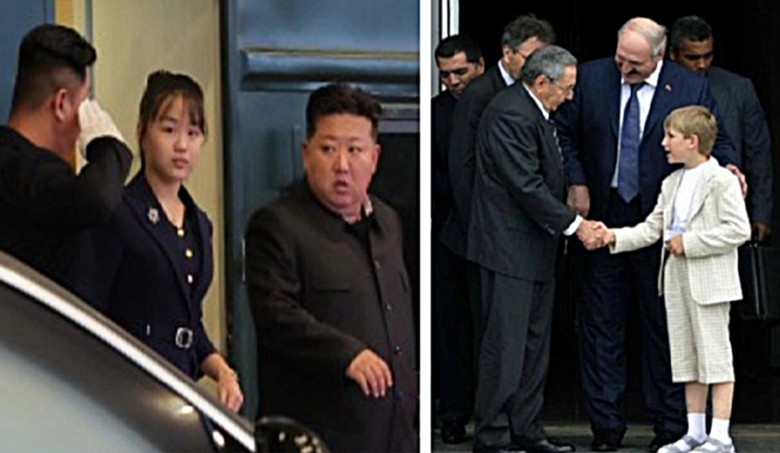This article is from the second edition (July-September 2025) of 38 North’s new quarterly product, North Korea Briefing, that monitors key internal developments in North Korea. For the full series, click here.
Kim Jong Un (KJU) visited China from September 2 to 4, 2025 to attend the 80th anniversary of China’s victory in the Second World War. Kim Ju Ae accompanied her father, expanding the types of public activities in which she participates.
Kim Ju Ae was the first child of a North Korean leader to openly go on an official foreign visit since her grandfather, Kim Jong Il (KJI), accompanied Kim Il Sung on a 1965 visit to Indonesia. There were rumors that KJU and his brother Jong Chol joined their father KJI on his 2007 visit to China and rumors KJU went to China in 2010. Neither rumor has ever been substantiated. Kim Ju Ae was not observed participating in any public engagements and according to the ROK government, she did not leave her accommodation at the DPRK Embassy in Beijing during the entire visit.[1]
We might contrast Kim Ju Ae against Nikolai Lukashenko, the third son of Belarusian leader Alexander Lukashenko. The younger Lukashenko was first brought out in public when he was 4 years old and greeted foreign leadership.
Figure 1. (Left) Kim Jong Un and his daughter stepping off the train in Beijing (Photo: Korean Central Television); (right) Nikolai Lukashenko, aged 8, meeting then Cuban leader Raul Castro in 2012 (Photo: Cubadebate).
Context and Implications
Kim Ju Ae’s visit to China fits the pattern of her activities in the DPRK—she is along for the ride and has few interactions outside of those with her father and his close aides. Going on a foreign visit adds another credential to her list of public engagements, which suggests she is being prepared to become a core North Korean elite, either the next supreme leader or a top party official.
Currently, based on the type of events in which Ju Ae participates and the senior DPRK officials with whom she interacts, she is the odds-on favorite as leadership successor. And yet, hereditary succession is still in early innings, and nothing is known of KJU’s other children. Ju Ae may not become supreme leader, but her presence in DPRK public life in the early 2020s indicates that some thought is being paid to next-generation political leadership.
KJU’s own succession to the supreme leadership has probably motivated him to begin some degree of planning. After all, his succession drive was somewhat hurried and improvised, driven by his father’s flagging health and a lack of a systemized framework for KJU to acquire the experience and skills commensurate to the supreme leadership. When he became leader, KJU had some loose ends to tie up: he had to reclaim all the six keys of the North Korean leadership and win over some of his father’s close aides. What KJU might envision for his successor, of which he was largely deprived, is a co-leadership period in similar fashion to KJI and Kim Il Sung.
The Six Keys
Based on past DPRK practices in succession and transition, there are about six keys of the North Korean supreme leadership. The keys refer to the bare minimal number of organizations, processes, and personnel that the supreme leader or a fledgling Kim leader needs to monopolize and control to lay claim to stable leadership. The keys are derived from prior analytic assessments by the author that focused on KJI’s succession in the years 1974 to 1976 and 1987 to 1992, transition planning from 2007 to 2009, and KJU’s succession and transition from 2009 to 2014. The keys are:
- Command and control of North Korea’s armed forces and strategic weapons;
- Control over Office No. 39 and the WPK Finance and Accounting Department;
- Control of paperwork traffic across the regime;
- Control of personnel appointments and status in the Military Security Command, State Security Department, and the Ministry of Public Security;
- Control over press, media, and broadcasting; and
- Control of the Guard Command and Personal Secretariat.
KJU knows that none of his or his sister’s children will be able to assume office for at least 10 years without regency. KJI began working at the WPK Central Committee when he was 23 years old. KJU himself became the leader of the DPRK when he was 27.
Until Kim Ju Ae, her siblings and/or cousins reach their 20s, KJU and his advisers will most likely focus on strategic policies to shape the domestic and regional landscape his successor will have to traverse. He will have to tweak the DPRK political and decision-making culture to accommodate a potential co-leadership and create the process and organizational interface to ensure a smooth transition. Part of this will involve publicity and indoctrination efforts justifying fourth-generation succession. If Ju Ae is selected as successor, then part of these publicity and indoctrination efforts will attempt to create conditions to support North Korea’s first female supreme leader.
Hereditary succession is an existential concern of the North Korean leadership, like its WMD program. Fortunately, as with nuclear negotiations, KJU has time on his side.





